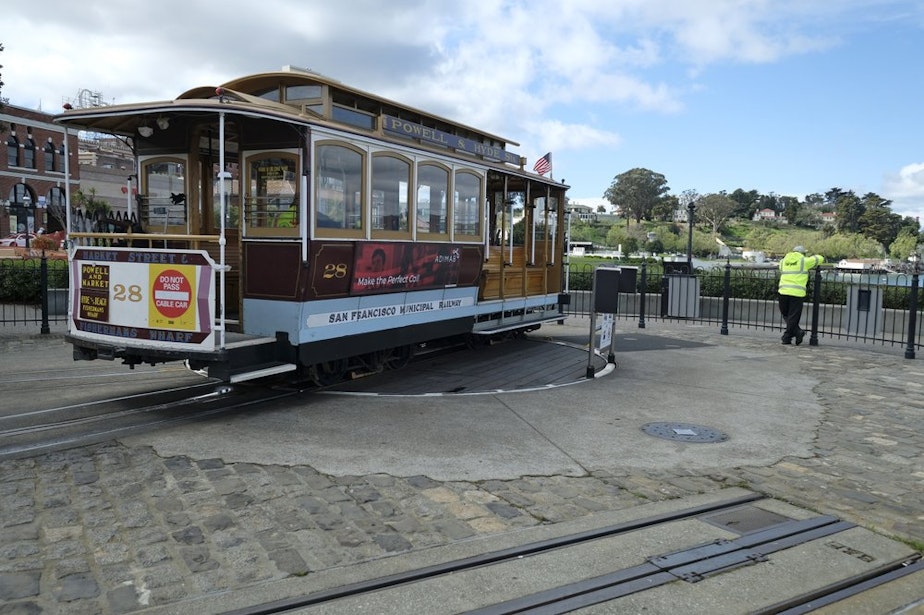The Bay Area has been ordered to shelter-in-place. What does that entail?

Here in Washington State, we're hunkered down at home, separated from our friends and our co-workers. We're no longer meeting up in restaurants or other places we usually gather, but so far, we're free to move about.
In California's Bay Area, 7 million people have been told to “shelter-in-place.” We asked Lesley McClurg, science reporter at KQED in San Francisco, what that means for people's lives and what she’s seeing on the streets.
“So I took a bike ride this morning in my neighborhood [in Oakland], which is near a commercial area. There's lots of little shops and grocery stores, etc., and it was a real mix. There were parts of the neighborhood that felt kind of apocalyptic. There weren't that many people on the streets. There weren't any kids playing in the yards.
Down in the commercial zone, it was also kind of a mix because there were lots of stores that were shuttered and even had their gates pulled down, closed for business. All restaurants had signs out front that said takeout only. But the grocery store I went by, a Safeway, was buzzing.
There's another little mom and pop grocery store with some farmers market stands out front with vegetables and fruits. People were picking over those. Definitely fewer people and yet kind of eerily in between zones.”
So what exactly does the shelter-in-place order do?
“It defines all essential travel so you can still go about your business if you need to go to the grocery store to get food, if you need to care for a friend or a relative. If you need to go to the doctor you can do that. You can go to the pharmacy, bank.
Sponsored
There's kind of this list of essential things that we all need to do to keep our lives running that we can still do, but we can no longer go to restaurants and sit down, or go to a bar, can't hang out with friends. You're supposed to stay six feet apart from people. So it's basically stay home as much as you can.”
I understand you can go outside, you can go walk your dog, for example, but you just have to be six feet away from someone outside as well. Right?
“Exactly. You can go for a hike by yourself for as long as you want in the woods. You can go out for a bike ride. You can, like I said, play by yourself. You're just not supposed to do that with other people.”
Telling seven plus million people to stay home, is this enforceable?
“It's a really good question that we're about to find out. Police are out and about saying that they're not ticketing right now, but they are educating. You can get a misdemeanor if you are doing something that is not essential travel, but they are not enforcing that right now.
Sponsored
So I think, really, we're kind of in an hour by hour, day by day basis to see how this is going to work and whether or not this can reduce the number of cases on the ground.”
Right now, California has less than half the number of confirmed coronavirus cases, as Washington State does, but officials decided to go ahead and put these greater restrictions in place. Why?
“I think it's a really good question and kind of a scary question to think through in the sense that I have to guess that they're doing this because they're extremely worried about our capacity to meet patient needs right now: having enough hospital beds, having enough intensive care units, potentially having enough healthcare workers.
There's not a very good count of how many people actually have this virus, but clearly they think the official numbers are quite under the reality to put this kind of a measure into place.”
Is California's health care system already operating at capacity?
Sponsored
“The nurses and doctors that I have talked to you this last week definitely had a bit of fear in their eyes in the sense that we’ve seen a spike recently in flu cases. Emergency rooms on a good day have bottlenecks throughout the California region and throughout the Bay Area. So there is a lot of nervousness about our ability to meet the needs of a potential influx of cases in the coming days.”
The Shelter in Place Order is relatively new. What's the reaction from people you've talked to about this?
“I would say for the most part, I have been actually really surprised by how people are responding to this and taking this very seriously. Obviously, I might be living in a little bit of a news bubble as a reporter on this but my neighbors seem to be really taking this seriously.
As I look out my window there is usually a number of people out front playing. I know all of my neighbors have kids at home right now. I'm not seeing any of them out in the yard playing so I think people are taking this seriously.
I am seeing some buzz on social media- folks thinking that this is an overreaction to the situation. But definitely, each day feels like we are swallowing the reality of what is happening more and more. People are changing their lives to reflect that, hopefully fast enough.”
Sponsored
Listen to the interview by clicking the play button above.





